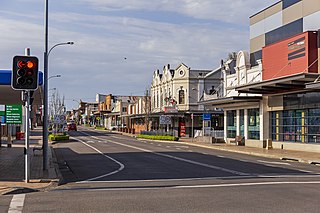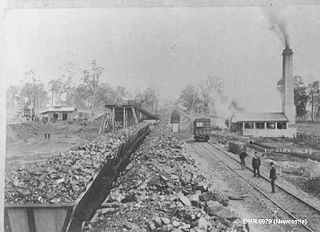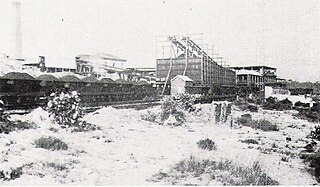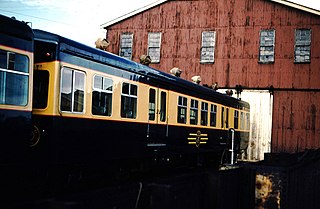
Cessnock is a city in the Hunter Valley of New South Wales, Australia, about 52 km (32 mi) by road west of Newcastle. It is the administrative centre of the City of Cessnock LGA and was named after an 1826 grant of land called Cessnock Estate, which was owned by John Campbell. The local area was once known as "The Coalfields", and it is the gateway city to the vineyards of the Hunter Valley, which includes Pokolbin, Mount View, Lovedale, Broke, Rothbury, and Branxton.

The Australian Agricultural Company is a public-listed Australian company that, as of 2018, owns and operates feedlots and farms covering around seven million hectares of land in Queensland and the Northern Territory, roughly one percent of Australia's land mass. As of July 2008 AACo had a staff of 500 and operated 24 cattle stations and two feedlots, consisting of over 565,000 beef cattle.
The South Maitland coalfields was the most extensive coalfield in New South Wales until the great coal mining slump of the 1960s. It was discovered by Lieutenant-Colonel William Paterson's party when they were engaged in an exploratory visit to the Hunter Valley during July 1801.

Kurri Kurri is a small town in the Hunter Region of New South Wales, Australia, in the Cessnock LGA. At the 2021 census, its population was 6,174. Kurri Kurri is the largest town in a group of towns and hamlets, including Stanford Merthyr, Pelaw Main, Weston, Abermain and Heddon Greta, called Kurri Kurri - Abermain by the ABS. Its estimated population was 20,631 at the 2021 census. The population of the Kurri Kurri built-up area was 20,015 at the 2021 census.

Greta is a small town in the Hunter Region of New South Wales, Australia.

Abernethy is a small town in the City of Cessnock, in the Hunter Region in the state of New South Wales, Australia. Abernethy is located 8 kilometres south-east of the town of Cessnock, NSW and is adjacent to Werakata National Park and the Aberdare State Forest. The town was founded near a coal mine and some of the historic buildings remain. In 2016 348 lived there with the median age being 32 and 74.8% being born in Australia.
Aberdare is a suburb of Cessnock, a large town based on coal mining in the Lower Hunter Region, New South Wales, Australia. Aberdare is a small suburb just 15 minutes' from wine country, 45 minutes to Newcastle and two hours to Sydney. George Brown found coal in the area in 1800's. Coal mining created the land boom of 1903-23 and by 1926 Cessnock had a population of 12,000 within a one-mile radius

John Marcus Baddeley was an Australian politician and member of the New South Wales Legislative Assembly from 25 March 1922 to 8 September 1949.

The South Maitland Railway was once an extensive network of privately owned colliery and passenger railway lines which served the South Maitland coalfields in the Hunter Region of New South Wales, Australia and were the second last system in Australia to use steam haulage, having used steam locomotives until 1983.

The Richmond Vale Railway was a 4 ft 8+1⁄2 in colliery railway line in the Hunter Valley of New South Wales, Australia, servicing coal mines at Minmi, Stockrington, Pelaw Main and Richmond Main. It was over 26 km (16 mi) long and passed through three tunnels, and was the last commercially operated railway in Australia to use steam locomotives.

Pelaw Main is a hamlet a few kilometres south-west of Kurri Kurri, in the Hunter Region of New South Wales, Australia. It owes its origins entirely to the colliery there of the same name. It had a population of 1,027 in 2011

Gillieston Heights is a suburb of the City of Maitland local government area in the Hunter Region of New South Wales, Australia, approximately 5.1 km (3.2 mi) from the Maitland CBD. Prior to 1967, the village was named East Greta however this was changed to honour former Maitland mayor and member of the New South Wales Legislative Assembly John Gillies following a poll of residents. At the 2021 census, Gillieston Heights had a population of 4,796.
The Austar coal mine is a coal mine located near Paxton, New South Wales. The mine has coal reserves amounting to 221 million tonnes of coking coal, one of the largest coal reserves in Asia and the world. In 2012, the mine had an annual production capacity of 3 million tonnes of coal and employed 409 people.
Quorrobolong is a small locality in the Hunter Region of New South Wales, Australia. It is located 11 km (7 mi) southeast of the town of Cessnock and is adjacent to Watagans National Park.

Australian Agricultural Company Mine Manager's House is a heritage-listed former colliery official's residence at 195 Denison Street, Hamilton, a suburb of Newcastle, New South Wales, Australia. It was built from 1849 to 1920. It is also known as A.A. Company House and A. A. Company Mine Manager's Cottage. It was added to the New South Wales State Heritage Register on 25 August 2017.

South Maitland Railway Workshops is a heritage-listed former railway workshops and now museum and industrial site at Junction Street, Telarah, New South Wales, Australia. It was added to the New South Wales State Heritage Register on 2 April 1999.
The 1923 Bellbird Mining Disaster took place on 1 September 1923 when there was a fire at Hetton-Bellbird coal mine, known locally as the Bellbird Colliery or mine. The coal mine was located near the village of Bellbird, which is itself three miles southwest of Cessnock in the Northern coalfields of New South Wales, Australia. The accident occurred in the No. 1 Workings of the mine and resulted in the deaths of 21 miners and their horses. At the time of the disaster the mine employed 538 people including 369 who worked underground.
The Hill End Colliery fire was an underground coal-seam fire. it burned from, at latest, August 1930 to at least early 1945, and most probably as late as June 1949. The impact of the fire was magnified by its close proximity to the mining town of Cessnock, New South Wales, Australia. The worst and most spectacular outbreak of the fire occurred on 8, 9 and 10 March 1933.
James Comerford was an Australian trade unionist, activist, writer and miner who was national general secretary of the Australian Coal and Shale Employees' Federation and served as its Northern New South Wales president from 1953 to 1973.












